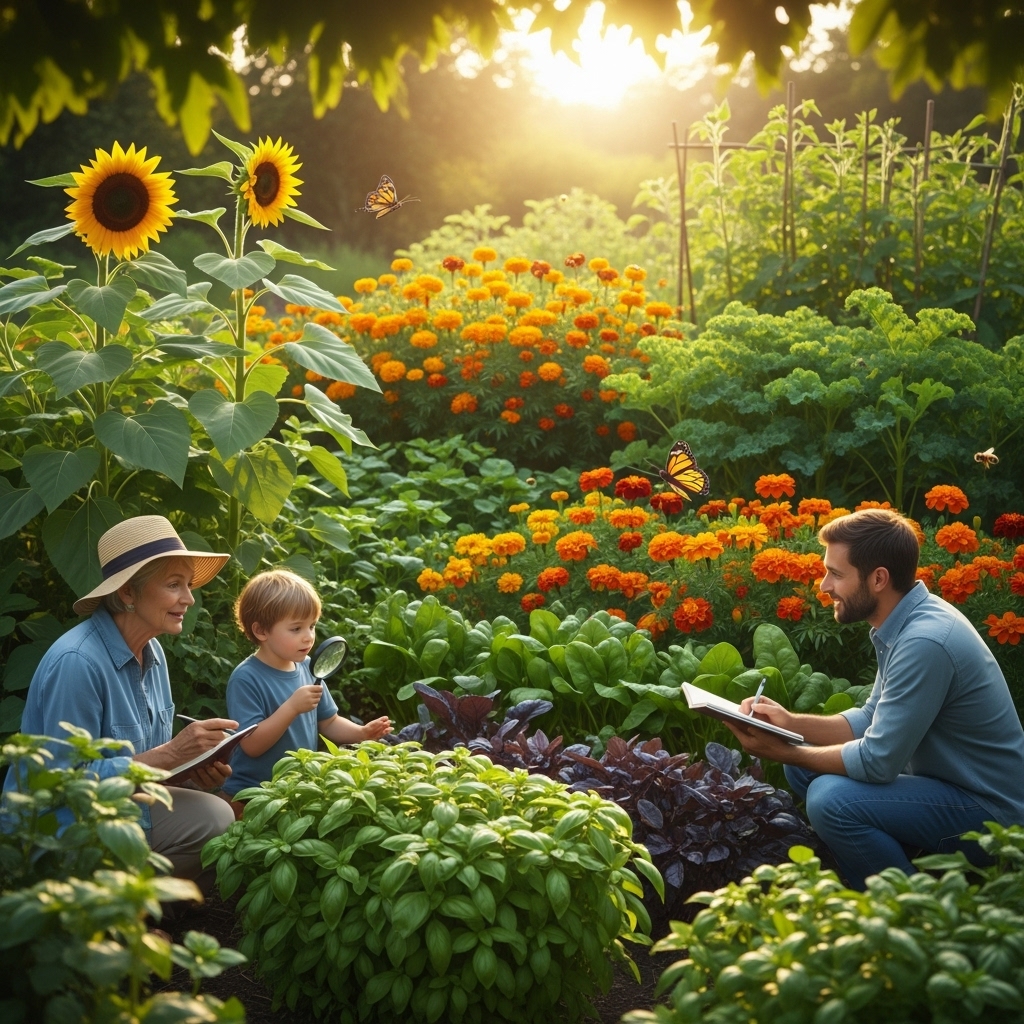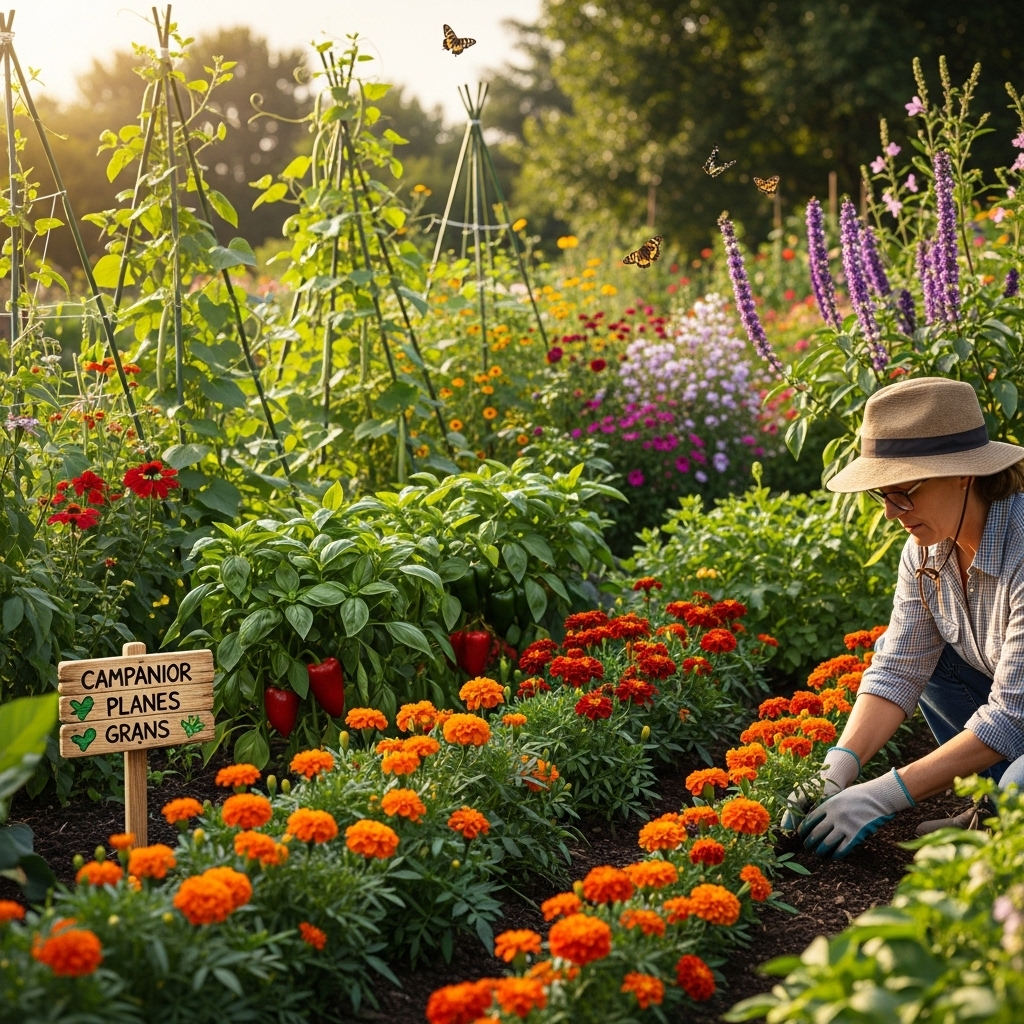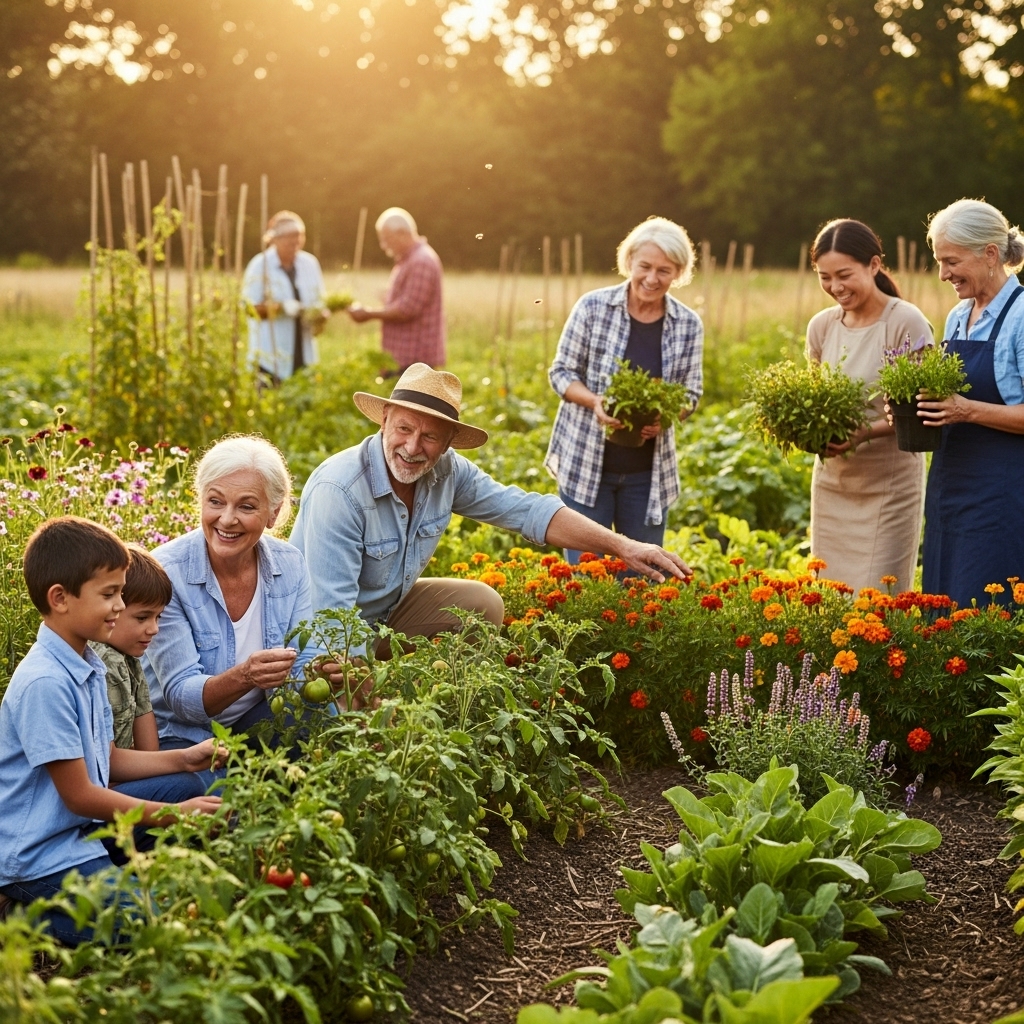Companion planting has transformed the way I view gardening, turning my patch of earth into a vibrant ecosystem. Join me as I explore the art and science behind pairing plants to enhance growth, deter pests, and create a thriving garden.
Understanding Companion Planting

When I first stumbled upon the concept of companion planting, I was fascinated by the idea that certain plants could benefit each other when grown in proximity. This method is steeped in tradition and environmental wisdom, drawing on centuries of agricultural practices. It’s not just about aesthetic appeal; companion planting is a practical strategy to create a more productive and resilient garden. I’ve learned that the relationships among plants can involve a variety of interactions, including attraction, repulsion, and support, which can boost growth and yield while minimizing pest problems.
The Science Behind Companion Planting
One of the most compelling aspects of companion planting is the underlying science. Plants can interact in ways that either enhance or inhibit each other’s growth. For example, certain plants release natural chemicals into the soil or air, which can repel pests or attract beneficial insects. I’ve found that marigolds are an excellent companion for nearly any vegetable because they emit substances that deter nematodes and other pests. Similarly, basil is known to improve the flavor of tomatoes while protecting them from whiteflies. This synergy is what makes companion planting an effective strategy for any gardener.
Different Types of Companion Planting
As I delved deeper into companion planting, I discovered that not all plant partnerships are created equal. I’ve categorized these relationships into several types, each with unique benefits:
- Mutualism: This is the most beneficial relationship, where both plants thrive together. For instance, planting garlic near roses can help deter aphids, benefiting both plants.
- Support: Some plants provide physical support for others. For instance, I often plant pole beans next to corn; the beans climb up the corn stalks, while the corn benefits from the nitrogen fixed by the beans.
- Repellent: Certain plants can repel pests from their companions. For example, I always plant nasturtiums near my cucumber plants. The nasturtiums draw aphids away from the cucumbers, keeping them healthy.
- Attractant: Some plants attract beneficial insects that prey on pests. I’ve found that planting dill and fennel can draw in ladybugs, which feast on aphids.
Planning Your Companion Planting Strategy
Creating a successful companion planting strategy requires some planning. I typically start by assessing my garden space, considering factors such as sunlight, soil type, and the specific plants I want to grow. Here’s how I approach it:
- Research Plant Pairings: I refer to various companion planting guides that detail which plants work well together. I make a list of potential pairings based on my garden goals. For instance, if I want to maximize space, I might look for plants that grow vertically, like cucumbers, to plant alongside low-growing crops, like lettuce.
- Consider Growth Habits: It’s crucial to consider the growth habits of the plants I’m pairing. Some plants grow tall and can shade their companions, while others may outcompete them for nutrients. I’ve learned to place taller plants like sunflowers on the north side of my garden so they don’t block light from shorter plants.
- Timing and Seasonality: Timing is everything in gardening. I carefully plan when to plant each species based on their growing seasons. For instance, I often plant cool-season crops like peas alongside warm-season crops like tomatoes, allowing for efficient use of garden space.
Common Companion Planting Mistakes to Avoid
As I’ve experimented with companion planting, I’ve made my fair share of mistakes. Here are some pitfalls to watch out for:
- Ignoring Plant Compatibility: Not every plant is a good neighbor. I’ve learned the hard way that some plants can inhibit each other’s growth. For example, I once planted cabbage near strawberries, which stunted both plants. It’s essential to research compatibility before planting.
- Overcrowding: While companion planting can maximize space, I’ve found that overcrowding can lead to competition for nutrients and water. I always ensure that I give each plant adequate space to grow.
- Neglecting Soil Health: Healthy soil is the foundation of a thriving garden. I prioritize soil health through crop rotation and regularly adding organic matter, ensuring my plants have the nutrients they need to thrive.
By understanding the principles of companion planting and being mindful of my plant choices, I’ve been able to create a more productive and harmonious garden. The benefits of this practice extend beyond just pest control; the relationships I cultivate among my plants enrich the entire ecosystem, making my gardening experience all the more rewarding.
Seasonal Companion Planting

As the seasons change, so do my gardening strategies, particularly when it comes to companion planting. I’ve learned that each season brings different opportunities and challenges, and adapting my pairings accordingly can make a significant difference in my garden’s productivity. I’ve found that understanding the seasonal dynamics of plants not only helps me maximize my yield but also enhances my overall gardening experience.
Spring Planting
Spring is an exciting time in the garden. After a long winter, I can’t wait to get my hands dirty and start planting. In the spring, I focus on cool-season crops like peas, lettuce, and kale. I’ve discovered that planting these alongside radishes and carrots can be advantageous. The radishes mature quickly, allowing me to harvest them before they can compete with the slower-growing crops. Meanwhile, the leafy greens provide shade for the carrots, preventing them from bolting in the early heat.
Another pairing I love during spring is beans with corn. I’ve planted pole beans alongside corn multiple times, and the results have always been rewarding. The beans benefit from the corn’s height for support, while the beans enrich the soil with nitrogen, which in turn nourishes the corn. It’s a classic example of mutualism that I enjoy witnessing as my garden flourishes.
Summer Strategies
As summer rolls around, I shift my focus to warm-season crops, such as tomatoes, peppers, and zucchini. I’ve found that companion planting becomes even more critical during this time, especially for pest management. This is when I turn to my trusty marigolds once more. By scattering them throughout my vegetable garden, I’ve noticed a significant reduction in pest populations, particularly aphids and whiteflies.
Additionally, I love pairing tomatoes with basil and oregano. Not only do these herbs thrive together, but they also create a delicious flavor combination for my summer dishes. The aromatic oils in basil can help mask the scent of tomatoes, making it harder for pests to find them. In my experience, this combination creates a thriving micro-ecosystem that benefits both culinary and aesthetic aspects of my garden.
Fall Planting and Crop Rotation
Fall brings a sense of urgency as the growing season starts to wind down. During this time, I’ve found that planting cover crops, such as clover or vetch, can be incredibly beneficial for my soil. These crops fix nitrogen and help prevent erosion over the winter months. I always intersperse these with my remaining fall crops, like broccoli and Brussels sprouts, to maximize both soil health and harvest.
In the fall, I also take the opportunity to rotate my crops, which is essential for maintaining soil fertility and preventing pests. After a season of heavy feeders like tomatoes, I plant legumes or leafy greens to replenish the soil’s nutrients. This practice has taught me the importance of planning ahead and considering the long-term health of my garden.
Adapting to Climate Variability
Living in a region with unpredictable weather patterns has taught me to be flexible with my companion planting tactics. I’ve found that paying attention to local climate trends can inform my decisions. For instance, during particularly dry spells, I’ve learned to group plants with similar water needs together. This not only conserves water but also fosters a healthier environment for my plants. I often plant drought-resistant varieties, like succulents, alongside more moisture-loving plants to create a microclimate that can provide some relief during arid conditions.
Moreover, keeping an eye on pests and diseases that fluctuate with the seasons has allowed me to adapt my planting schedule. For example, if I notice that aphid populations are on the rise, I may decide to plant more attractant plants, such as dill, to draw in beneficial insects like ladybugs. This proactive approach has saved many of my plants from pest damage, and it’s gratifying to see the balance restored in my garden.
Building a Companion Planting Community

One of the most rewarding aspects of my gardening journey has been sharing my experiences and knowledge with others. I’ve started engaging with local gardening clubs and online communities, where I can exchange ideas about companion planting. I love hearing about what strategies have worked for others and learning about new plant pairings that I haven’t yet tried. It’s fascinating to see how different climates and soil types influence companion planting strategies.
I’ve also found that organizing group gardening projects can be a fun way to implement companion planting on a larger scale. Collaborating with others not only fosters a sense of community but also allows us to experiment with diverse plant pairings that we may not have considered individually. Whether we’re planting a community vegetable garden or setting up a pollinator garden, the shared knowledge and camaraderie make the experience even more enriching.
Through these interactions, I’ve come to realize that gardening is more than just a solitary activity; it’s a collective effort that can bring us all closer to nature and to each other. My journey in companion planting has transformed my garden into a thriving ecosystem, and I enjoy sharing that journey with fellow gardening enthusiasts.
Advanced Companion Planting Techniques

As I’ve gained more experience with companion planting, I’ve begun to explore advanced techniques that can further enhance the benefits of my garden. These methods have not only increased my yields but have also deepened my understanding of plant interactions. Here are a few strategies that I’ve found particularly effective.
Intercropping
Intercropping has become one of my favorite practices. This involves planting two or more crops in proximity for various benefits. I’ve noticed that by intercropping, I can maximize space and resources while minimizing competition. For instance, I often plant carrots and radishes together. The fast-growing radishes mature quickly, allowing me to harvest them before they compete for nutrients with the slower-growing carrots. Similarly, I love mixing lettuce with taller plants like tomatoes; the lettuce benefits from the shade provided by the tomato plants during the hot summer months.
Another successful intercropping combination I’ve tried is planting garlic between my peppers. The garlic not only deters pests that might attack the peppers but also has a minimal growth habit, allowing both crops to thrive without overcrowding each other. This practice has taught me the importance of timing and planning, as I always consider the growth rates and sizes of the plants I choose to pair.
Layered Planting
Layered planting is another technique that has transformed my garden. This strategy involves planting crops at different heights to make the most of vertical space and sunlight. When I layer plants, I create a more diverse ecosystem that supports various forms of life. For example, I’ve started planting tall sunflowers at the back of my garden bed, followed by medium-height plants like tomatoes, and then low-growing herbs or leafy greens at the front. This arrangement not only looks beautiful but also allows each plant to receive the appropriate amount of sunlight.
Additionally, I often incorporate ground cover plants, like clover or creeping thyme, to protect the soil and suppress weeds. These plants help retain moisture and provide habitat for beneficial insects. By layering my planting, I’ve created a more dynamic and resilient garden that promotes biodiversity and reduces maintenance.
Using Companion Planting for Pest Management
One of the most rewarding aspects of companion planting has been its role in natural pest management. I’ve learned to utilize specific plant combinations that repel pests while attracting beneficial insects. For example, I’ve had great success planting marigolds alongside my vegetable crops. These vibrant flowers not only add color to my garden but are also known to deter nematodes and other harmful pests. By incorporating marigolds, I’ve seen a noticeable reduction in pest populations.
I also make use of trap crops. These are plants that attract pests away from my main crops. For instance, I plant mustard greens around my Brussels sprouts to lure away aphids. By sacrificing a small area of mustard greens, I protect my more valuable crops, and it’s been a win-win approach in my garden.
Experimenting with Perennial Companions
As I’ve grown more comfortable with companion planting, I’ve started experimenting with perennial plants that can provide long-term benefits. Perennials like chives, lavender, and sage not only come back year after year but also offer fantastic support for my seasonal crops. For instance, I’ve planted chives near my tomatoes and have noticed that they help repel aphids, while their roots improve soil health over time.
Incorporating perennials has also allowed me to reduce the amount of replanting I need to do each year, freeing up my time for other gardening activities. I cherish the idea of building a sustainable garden that requires less labor, and perennials are a crucial part of that vision. They also provide habitat for pollinators and beneficial insects, further enhancing the ecosystem in my garden.
Documenting My Findings
As I embark on this journey of advanced techniques, I’ve started documenting my findings in a gardening journal. Recording my planting dates, combinations, and subsequent results has been tremendously beneficial. I can refer back to my notes to identify which pairings were successful and which ones fell short. This practice has not only improved my gardening skills but has also given me a sense of pride in observing the evolution of my garden over time.
Through my journaling, I’ve been able to identify patterns in plant performance, pest pressure, and overall garden health. I’ve come to appreciate the unique microclimates within my garden and how different areas may favor specific plant pairings. This data-driven approach has made my gardening more intentional and rewarding.
Sharing and Learning from Others

As I continue to deepen my understanding of companion planting, I recognize the importance of sharing my insights and learning from fellow gardeners. I’ve found that participating in workshops, attending local gardening fairs, and engaging with online forums enhances my experience. Hearing about others’ successes and challenges inspires me, and I often bring back new ideas to try in my own garden.
Every conversation I have with fellow gardeners opens up new possibilities and perspectives. It’s incredible how diverse our approaches can be based on our unique climates and soil types. By sharing knowledge, we collectively foster a richer gardening community that benefits everyone involved.
I’ve even started hosting small gatherings at my home where fellow gardening enthusiasts can come together to share ideas and strategies. These meet-ups have been a great way to bond with others who share my passion for gardening, and we often leave inspired with fresh insights to apply in our own gardens.
Ultimately, the journey of companion planting has not only transformed my garden but has also enriched my connections with others. I look forward to continuing this adventure, exploring new techniques, and sharing the joys of gardening with my community.
